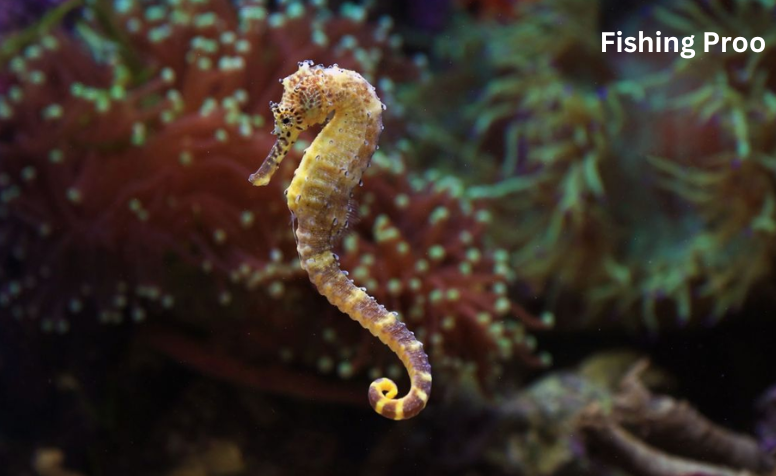Sea Horse
Any of the 46 species of tiny saltwater fish in the genus Hippocampus are known as seahorses. The word “Hippocampus” is derived from the Ancient Greek word “hippocampus,” which is made up of the words “horse” (hippos) and “sea monster” (kampyos).
Many people may not initially think of seahorses as “fish,” although that is correct because of their distinct physical shape and absence of scales. With swim bladders to help them stay afloat and gills to help them breathe

These fish also flourish in a robust coat of robust plates that resemble armor.
Nine of the twelve species identified in the Indo-Pacific are found in the coastal ecosystems of India. In shallow coastal waters, they can be found in latitudes ranging from roughly 52° N to 45°S. India’s seahorse populations are dispersed throughout a variety of habitats, including coral reefs, macroalgal beds, mangroves, and seagrass.
What gives it the name “seahorse”?
Traveler: Why are seahorses named as such? What makes them.
It also has a small mouth at the apex of a tube-shaped snout. This fish’s name “seahorse” probably comes from the fact that its head resembles a horse.
Why use a sea horse?
Dried sea horse is thought to be a treatment for respiratory conditions and kidney stones. In addition, Sea Horse relieves symptoms of dystocia, wheezing, asthma, enuresis, sores, boils, sleeplessness, and stomach pain.
Information About Seahorse You Should Know: They eat a lot.
- They never stop dating.
- Baby seahorses are born to males!
- They have useful tools in their tails.
- They are incredibly adept at hiding.
- Their eyes function separately from one another.
- Predators, that is, there aren’t many of them.
- They are distinguished by distinctive markings.
Seahorses mainly eat small crustaceans like amphipods and other invertebrates. Adult seahorses eat 30 to 50 times a day if available. They do not have a stomach or teeth, instead, they suck their prey in through a tubular snout, or a fused jaw, and pass it through an inefficient digestive system
Physical characteristics: Seahorses have a unique look. They feature horse-like heads, prehensile tails, tubular snouts, and elongated bodies with bone plates in place of scales. Their morphology makes it possible for them to blend quite well with coral and algae.
Dimensions: Seahorses come in different sizes; some species are barely 1.5 inches (3.8 cm) long, while larger species can reach lengths of up to 14 inches (35 cm).
Habitat: Seahorses live in shallow coastal waters, frequently in the midst of mangroves, coral reefs, and seagrass meadows. They favor places with lots of greenery and cover for them to cling to.
Unusual Reproduction: Among the animal kingdom’s most unusual reproductive systems is that of seahorses. The female fertilizes the developing eggs in the brood pouch that the male carries. The male seahorse gives birth to the young when they are ready, and they are completely autonomous from the moment of birth.
Diet: Because seahorses are carnivores, their main sources of food are small planktonic creatures and crustaceans, such shrimp. They draw in their prey by creating a vacuum with their snouts.
Swimming: Seahorses rely on their dorsal fin for propulsion because they are not very good swimmers. In order to prevent being carried away by currents, they are frequently observed clinging to seagrass or other items in the water.
Conservation: The loss of habitat, overfishing, and the aquarium trade pose threats to numerous species of seahorses. In certain communities, they are also utilized in traditional medicine. Therefore, in order to preserve these unusual animals, seahorse conservation initiatives are essential.
Cultural Significance: Seahorses are depicted in many mythology and cultures, and they have long captivated human imagination. They are frequently connected to grace, patience, and perseverance symbolism.
Research: Because of their unique reproductive techniques and ecological responsibilities, seahorses are of interest to scientists and researchers exploring areas such as marine biology, genetics, and conservation.
Diversity of Species: Seahorses are found in over 40 different species, each having distinct traits and geographic ranges.
CONCLUSION:
Seahorses are fascinating creatures that both scientists and marine fans find fascinating due to their fragile nature and unique activities.
Seahorses are amazing aquatic animals distinguished by their distinct looks and behaviors.
Many people may not initially think of seahorses as “fish,” although that is correct because of their distinct physical shape and absence of scales. These fish live in a powerful suit of robust armor-like plates and use their gills for breathing and swim bladders to stay buoyant in the water.
